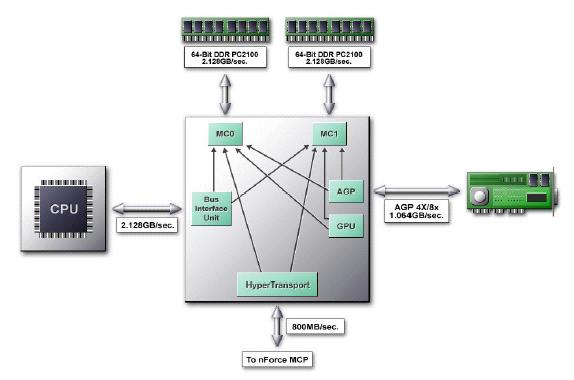TwinBank Memory Architecture
Like any other north bridge, one of the functions of the nForce IGP is providing the memory interface for the system. The IGP, however, goes a step further and offers a unique memory setup that NVIDIA likes to call TwinBank Memory Architecture. Basically, you get a 128-bit 133 MHz DDR memory interface, providing a total of 4.2GB/s of memory bandwidth - more than any other mainstream chipset on the market today.
While this is quite impressive, TwinBank is actually much more complex than just a dual PC2100 memory interface. In fact, the 128-bit memory bus is actually somewhat misleading - not because it's not really 128-bits wide, but because it doesn't tell the whole story. These 128-bits are actually divided up into dual-independent 64-bit memory buses, each with its own memory controller. This means that either the CPU or GPU can access either or both memory controllers, allowing for the most efficient use of memory bandwidth possible. This setup is precisely NVIDIA's Crossbar memory technology, first used in the GeForce3.
Of course, standard 184-pin DDR DIMM's are only 64-bits wide and NVIDIA has no interest in creating a new memory standard. As such, you'll have to install two DIMM's in an nForce 420 board to take advantage of TwinBank Architecture. The IGP-128 can fall back to 64-bit operation, at a performance hit of course, if only one DIMM is installed.

When we heard about the 128-bit memory interface on the nForce, we assumed that memory would have to be installed in matched pairs, but NVIDIA's tech docs state that this is not the case. Since each memory bank has its own memory controller, the modules can be different sizes and even different speeds. A Single Intelligent Arbiter decides which memory controller will handle what data. Nevertheless, our guess is that performance will be better if there is an equal amount of memory in each bank, since this will allow for the interleaving of data evenly between the two banks.
Interestingly enough, the IGP-128 supports 3 DIMM slots - an odd specification when there are two memory controllers. It turns out that the first slot is linked to the first memory controller and the other two slots are linked to the second memory controller. You'd think that the IGP would be able to support 4 DIMM slots with 2 in each bank, but obviously there was some sort of design issue that prevented them from doing this. We wouldn't be too surprised if some manufacturers come up with boards supporting 4 DIMMs. Once again, the memory controllers are completely independent of each other, so you can have unequal amounts of memory in each bank.
Note that there will be two version of the nForce IGP, one that supports the TwinBank 128-bit, 133 MHz DDR memory interface and one that only supports a standard 64-bit, 133 MHz DDR memory interface. The 128-bit model will be known as the IGP-128 and is included in the nForce 420 chipset, while the 64-bit model is the IGP-64 and is included in the nForce 220 chipset. Other than the memory interface, the two north bridges are identical.
Naturally, IGP-64 will have a lower pin count, making the chipset and boards cheaper to produce, but at a pretty hefty performance penalty. So far, we've yet to hear of an nForce 220 based product from any of the motherboard manufacturers, but they will undoubtedly come with time.










1 Comments
View All Comments
Drudy - Tuesday, June 1, 2021 - link
In order to fully equip your tablet, you need a quality provider to always stay in touch. I can advise you on the site https://vox.do/ where you can also find out about the services of international numbers with an increased tariff. I think you will find a lot of interesting details here.